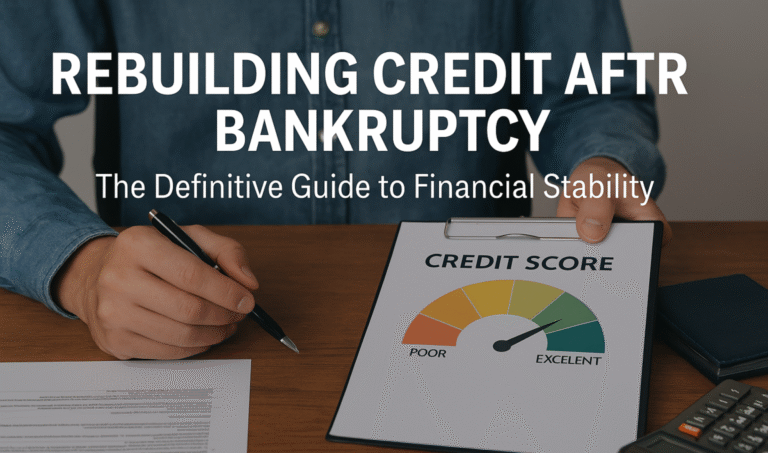Rebuilding Credit After Bankruptcy: The Definitive Guide to Financial Stability
Bankruptcy can feel like a hard reset. However, with the right plan, you can rebuild credit, restore your credit score, and regain long-term financial stability. This guide covers practical, step-by-step strategies that work in New York and New Jersey—particularly after a Chapter 7 bankruptcy filing.
1) What Bankruptcy Does to Your Credit
A bankruptcy discharge removes eligible debts and stops collections; nevertheless, the bankruptcy record remains on your credit file for a limited period—typically 10 years for Chapter 7. Despite that, lenders focus heavily on your behavior after filing. The path forward is to add fresh, positive data consistently.
A discharge should change discharged accounts to zero balance with no ongoing delinquency. If you still see “past due,” you’ll fix that in the dispute step below.
If you’re still evaluating options, learn about our flat-fee preparation for Chapter 7 bankruptcy in NY & NJ.
2) Credit Reports, Errors, and Disputes
First, pull your reports from all three bureaus—Equifax, Experian, and TransUnion—through the official portal at AnnualCreditReport.com. Then, review each report line by line.
Identify negative items: late payments, charge-offs, collections, and duplicated tradelines.
Confirm discharge updates: discharged accounts should show a zero balance and no open delinquency.
Dispute inaccuracies: use each bureau’s online dispute portal to fix status, balances, and dates.
Additionally, save PDFs of your reports and dispute confirmations. Re-check within 30–45 days to verify corrections.
3) Smart Ways to Add New Credit (Without Overshooting)
Rebuilding means adding small, well-managed accounts that report monthly. The following options are effective:
-
Secured credit card: Put down a $200–$500 deposit; use it for one or two predictable bills; pay in full every month. Many banks “graduate” you to unsecured after 6–12 months of solid use.
-
Credit-builder loan: Credit unions and community banks offer small installment loans where payments are reported to bureaus, creating positive history.
-
Authorized user: If a trusted person has a long, clean card history and low utilization, being added as an authorized user can boost your profile.
Because too many hard inquiries can lower your score, apply for one product at a time and wait 3–4 months before adding another.
4) On-Time Payments & Low Utilization Drive the Score
Payment history is the largest slice of most scoring models. Automate payments for utilities, phone, and the secured card to avoid being late. Manage your credit utilization carefully:
-
Target under 15% utilization (balance ÷ limit). For a $300 limit, keep the balance under $90.
-
Power tip: Aim for 1–9% reported utilization for maximum scoring benefit.
-
Never revolve by choice: Pay in full; interest doesn’t help your score.
Meanwhile, build a modest emergency fund (even $500–$1,000) so an unexpected bill doesn’t push you back into debt.
5) Monitor Your Credit Score & Catch Issues Early
Track your progress monthly so you can quickly address errors or unexpected dips. Free tools such as Experian, Credit Karma, and NerdWallet can help. Some services even provide alerts when new accounts or inquiries appear.
6) Add Positive “Alternative Data”
Not all good behavior shows up automatically. Add legitimate positive signals like these:
-
Report rent and utilities: Tools like Experian Boost can add certain bills to your file.
-
Cell and streaming services: Some companies can report these, too—verify which bureaus they reach.
-
Local credit union relationship: Opening a savings/checking combo and a small credit-builder loan can help, particularly after a Chapter 7 discharge.
7) Recovery Timeline & Realistic Expectations
Typically, within 18–24 months of consistent, low-risk credit use, many people move into the “good” range (often 650+). Results vary, but the formula is consistent: on-time payments, low utilization, and no unnecessary debt.
Lenders weigh recent history more heavily than older negative marks. Your fresh positive data will eventually outweigh the static presence of the bankruptcy record.
Need a Fresh Start? We Can Help.
We The People NYC prepares affordable bankruptcy documents for New York and New Jersey residents—no attorney needed. Start with a clean slate, then follow this guide to rebuild quickly and confidently.
Quick FAQ: Rebuilding Credit After Bankruptcy
How soon after discharge can I apply for new credit?
You can start with a secured card as soon as your discharge posts to your reports and your accounts are updated to zero balances. Wait 3–4 months before applying for anything else.
Will on-time utility and rent payments help my score?
Yes—if they’re reported. Consider services that add eligible payments to your file. Keep paying everything on time; payment history is the most influential factor.
What utilization should I target?
Stay under 15% at all times, and if possible, let 1–9% report. For example, on a $500 limit, allow $5–$45 to report, then pay it off.
Trusted by New Yorkers for Over 20 Years
For more than two decades, We The People has been a trusted name in affordable legal document preparation.
Our NYC office helps residents in all five boroughs, Westchester, and Nassau County complete divorce filings quickly, accurately, and affordably. Ultimately, our goal is to make the divorce process as simple as possible—without unnecessary stress.
Ready for a Fresh Start?
If you need a clean, organized path to Chapter 7 bankruptcy in New York City or New Jersey, We The People of New York can prepare your paperwork quickly and affordably. Schedule your free Chapter 7 eligibility review today and learn how to file bankruptcy in NYC with confidence.

